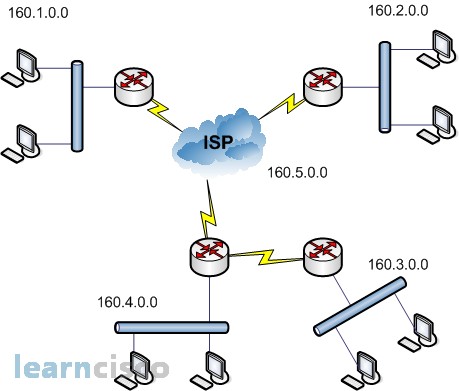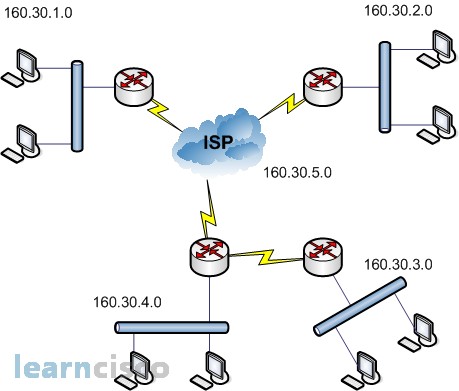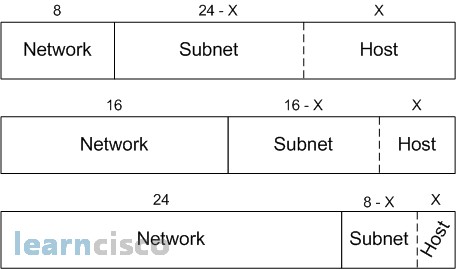An IP address is a numeric identifier assigned to each machine on an IP network. It designates the specific location of a device on the network.
Terminology:
- Bit – A bit is one digit, either a 1 or a 0.
- Byte – A byte is 8 bits.
- Octet – An octet, made up of 8 bits, is just an ordinary 8-bit binary number.
- Network address – This is the designation used in routing to send packets to a remote network – for example, 10.0.0.0, 172.16.0.0, and 192.168.1.0.
- Broadcast address – The address used by applications and hosts to send information to all nodes on a network is called the broadcast address. Examples include 255.255.255.255, which is all networks, all nodes; 172.16.255.255, which is all subnets and hosts on network 172.16.0.0; and 10.255.255.255, which broadcasts to all subnets and hosts on network 10.0.0.0.
An IP address consists of 32 bits of information. These bits are divided into four sections, referred to as octets or bytes, each containing 1 byte (8 bits). You can depict an IP address using one of three methods:
- Dotted-decimal, as in 172.20.18.125
- Binary, as in 10101100.00010100.00010010.01111101
The 32-bit IP address is a structured or hierarchical address, as opposed to a flat or nonhierarchical address. Although either type of addressing scheme could have been used, hierarchical addressing was chosen for a good reason. The advantage of this scheme is that it can handle a large number of addresses, namely 4.3 billion (a 32-bit address space with two possible values for each position – either 0 or 1 – gives you 232, or 4,294,967,296).
The network address (which can also be called the network number) uniquely identifies each network. Every machine on the same network shares that network address as part of its IP address. In the IP address 172.20.18.125, for example, 172.20 is the network address. The node address is assigned to, and uniquely identifies, each machine on a network. This part of the address must be unique because it identifies a particular machine – an individual – as opposed to a network, which is a group. This number can also be referred to as a host address. In the sample IP address 172.20.18.125, the 18.125 is the node address. The designers of the Internet decided to create classes of networks based on network size. For the small number of networks possessing a very large number of nodes, they created the rank Class A network. At the other extreme is the Class C network, which is reserved for the numerous networks with a small number of nodes. The class distinction for networks between very large and very small is predictably called the Class B network.
| Class A | Class B | Class C | |
|---|---|---|---|
| First Octet Range | 1 to 126 | 128 to 191 | 192 to 223 |
| Valid Network Numbers | 1.0.0.0 to 126.0.0.0 | 128.1.0.0 to 191.254.0.0 | 192.0.1.0 to 223.255.254.0 |
| Number of Networks in This Class | 27 – 2 | 214 – 2 | 221 – 2 |
| Number of Hosts per Network | 224 – 2 | 216 – 2 | 28 – 2 |
| Size of Network Part of Address (bytes/bits) | 1 / 8 | 2 / 16 | 3 / 24 |
| Size of Host Part of Address (bytes/bits) | 3 / 24 | 2 / 16 | 1 / 8 |
| Default Mask | 255.0.0.0 | 255.255.0.0 | 255.255.255.0 |
By definition, an IP address that begins with 8 in the first octet is in a Class A network, so the network part of the address is the first byte, or first octet. An address that begins with 130 is in a Class B network. By definition, Class B addresses have a 2-byte network part, as shown. Finally, any address that begins with 199 is in a Class C network, which has a 3-byte network part. Also by definition, a Class A address has a 3-byte host part, Class B has a 2- byte host part, and Class C has a 1-byte host part.
IP Subnetting
IP subnetting creates vastly larger numbers of smaller groups of IP addresses compared with simply using Class A, B, and C conventions. The Class A, B, and C rules still exist, but now a single Class A, B, or C network can be subdivided into many smaller groups. Subnetting treats a subdivision of a single Class A, B, or C network as if it were a network itself. By doing so, a single Class A, B, or C network can be subdivided into many nonoverlapping subnets. The following two figures are demonstrating the basic differences between a network that does not use subnetting and one that does. First, look at the next one, which uses six different IP networks.

The design shown here requires six groups, each of which is a Class B network. The four LANs each use a single Class B network. In other words, the LANs attached to Routers A, B, C, and D are each a separate network. Additionally, the two serial interfaces comprising the point-to-point serial link between Routers C and D use the same network, because these two interfaces are not separated by a router. Finally, the three router interfaces comprising the Frame Relay network with Routers A, B, and C are not separated by an IP router and would comprise the sixth network.
The next image uses six subnets, each of which is a subnet of a single Class B network. This design subnets Class B network 160.30.0.0. The IP network designer has chosen a mask of 255.255.255.0, the last octet of which implies 8 host bits. Because it is a Class B network, there are 16 network bits. Therefore, there are 8 subnet bits, which happen to be bits 17 through 24-in other words, the third octet.

Note that the network parts (the first two octets in this example) all begin with 150.150, meaning that each of the six subnets is a subnet of Class B network 150.150.0.0.
With subnetting, the third part of an IP address-namely, the subnet-appears in the middle of the address. This field is created by “stealing” or “borrowing” bits from the host part of the address. The size of the network part of the address never shrinks. In other words, Class A, B, and C rules still apply when you define the size of the network part of an address. However, the host part of the address shrinks to make room for the subnet part of the address. The following figure shows the format of addresses when subnetting is used.

Our Recommended Premium CCNA Training Resources
These are the best CCNA training resources online:
Click Here to get the Cisco CCNA Gold Bootcamp, the most comprehensive and highest rated CCNA course online with a 4.8 star rating from over 30,000 public reviews. I recommend this as your primary study source to learn all the topics on the exam.

Want to take your practice tests to the next level? AlphaPreps purpose-built Cisco test engine has the largest question bank, adaptive questions, and advanced reporting which tells you exactly when you are ready to pass the real exam. Click here for your free trial.
